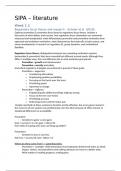SIPA – literature
Week 1.1
Regulatory focus theory and research – Scholer et al. (2019).
Explores promotion & prevention focus based on regulatory focus theory. Includes a
discussion of what defines each system, how regulatory focus orientations are commonly
measured and manipulated, what differentiates promotion and prevention motivation from
approach and avoidance motivation, what characterizes the trade-offs of each system, and
newer developments in research on regulatory fit, group dynamics, and motivational
flexibility
Regulatory focus theory: distinguishes between two coexisting motivation systems
(promotion & prevention) that serve essential but different survival needs. Although they
differ in multiple ways, the core difference lies in what motivates goal pursuit:
- Promotion = growth and advancement
- Prevention = security and safety
And which regulatory strategies are preferred in pursuit of these goals:
- Promotion = eagerness
o Considering alternatives
o Emphasizing positive possibilities
o Focusing on the forest over the trees
o Prioritizing speed
o Openness to change
- Prevention = vigilance
o Emphasizing the ability that things might go wrong
o Focus on the tree over forest
o Prioritizing accuracy
o Embracing norms and the status quo
People need both of these systems to function and be effective, but at any given moment,
the concerns of one system may predominate over the other because of either chronic or
situational differences in accessibility.
Promotion:
- Sensitive to gains vs non-gains
Gain = success (+1), non-gain = failure (0)
Even when it’s going well, how can things go better?
Prevention:
- Sensitive to loss vs non-loss
Non-loss = success (0), loss= failure (-1)
Where do these come from? -> parenting styles
- Promotion = caretaker-child interactions that emphasize desired end states as ideals
(hopes, wishes, and aspirations) and making advances to move to a better state.
What matters is making progress, making gains.
,Nurturing & bolstering
- Prevention: interactions that emphasize desired end states as oughts (Duties,
responsibilities, and obligations) and maintain a satisfactory state rather than a
worse state. What matters is to maintain safety and security.
Punitive & controlling
However, everyone has both systems, and they can also become salient due to a situation,
relationship, and salient identity.
These systems are orthogonal, such that at a chronic level, people can simultaneously have
strong promotion and prevention systems. However, at any given moment, one is dominant.
Measurements:
- Regulatory focus strength measure
- Regulatory focus questionnaire
Manipulations:
- Framing of a task as nongain/gain or nonloss/loss
- Remember episodes from the participant successfully used either system
- Priming ideals or oughts
- Maze that highlights nurturance vs security
- Reflect on current ideals or oughts
Difference from approach and avoidance
- System-level: an individual’s overarching motivational concerns and goals. Goals
serve as the end states, standards, or
reference points that guide behaviour
Approach = regulating in relation to a desired
end state
Avoidance = regulated in relation to an
undesired end state
Approach & avoidance for each focus
Ex)Promotion = approaching gains, ideals and
growth.
Avoiding losses and danger
- Strategy level
- Tactic level
Success vs failure
Promotion:
Success = presence of positive outcome, cheerfulness-related emotions like happiness and
joy
Failure = lack of positive outcome, dejection-related emotions like sadness and
disappointment
Prevention:
Success= absence of a negative outcome, quiescence-related emotions like peacefulness
and calm
, Failure = presence of negative outcome, agitation-related emotions like anxiety and worry
Neural activation
Study:
Two months beforehand they received information on
Con1: the person they ideally wanted to be = promotion goal
Con2: the person they believed it was their obligation to be = prevention goal
They were both concerning ideal end states, but the regulatory focus was different
Promotion = brain regions related to reward
Prevention = brain regions related to self in relation to others
The Catalyst – Berger (xx)
Chapter 4: Uncertainty
The uncertainty tax: getting people to try something new.
Effect of uncertainty:
- Decrease the value of new things
Uncertainty in studies: Give people a choice between a certain, good thing and an uncertain
but potentially better thing and see what they pick. Here people do not make the ‘rational’
choice, but the guaranteed one.
Risk aversion
So, they devalue things that are uncertain = uncertainty tax, the cost of uncertainty
The uncertain thing has to be a lot nicer to be picked.
(ex: gift card from lec)
- Halt decision making altogether
Example: pass/fail exam and vacation.
When people are uncertain if they passed or failed, they were likely to defer the choice of
the holiday, even though in both the pass and fail condition they chose to go.
Uncertainty makes people wait and stick with whatever they have always been doing.
How can we get people to unpause?
Roger’s diffusion model, how quickly things are adopted.
Key concept = trialability, how easy it is to try something. The ease with which something
can be tested or experimented with on a limited basis. The easier something is to try, the
more people will use it, and the faster it catches on.
How to reduce uncertainty by increase triability:
1. Harness freemium = free but upgrade to premium for certain features
2. Reduce up-front costs, like offering free shipping
This it is not only about money, but can also be about time or effort
Ex: drowning simulation
3. Drive discovery, making yourself more known
Ex: Acura pairing up with a hotel branch to offer their car for free rides.
4. Make it reversible, like trial periods
Which method works best is case to case specific




